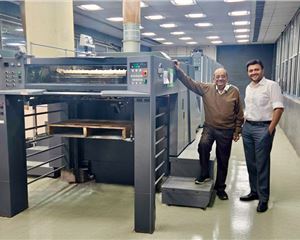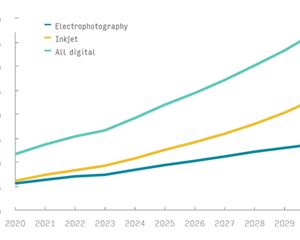GV Sreekumar, associate professor, Industrial Design Centre at IIT Bombay, looks at graphic design education in India and recommends tips to better the world of typography and print-making.
India got into graphic design education early and has stayed the course. It looks poised to have a promising future as well.
In the 1950s, many art schools began offering a course in “applied art”. A clear understanding of the genre of graphic design education was not established in the minds of educators and policy makers.
Of late, the private sector has emerged as a visible presence in this area of education. Many of them are affiliated to universities. With the boom in design schools in the private sector, it is time to have a relook at the structure and administration of design education in India.
There are many flaws in our design set-ups, which need to be addressed urgently. For instance, even where the curriculum is well written, there are no systems in place to ensure that all the points of the curriculum are covered in class.
So, while the flourishing of design schools is an encouraging sign, there are certain uncomplimentary facets of this genre of education that need to be brought into the realm of public discussion. It is unfortunate that at the undergraduate level, almost all the applied art institutes still follow a curriculum created by the British in the ‘50s. The curriculum was tailormade to meet the workforce requirements of the advertising industry at that time and intended to generate professionals who could execute ideas of another set of creative directors and copy writers – a profession dominated by the foreigners.
Training is focused on execution and the technical expertise required by the advertising industry, rather than on concept generation. Thus, at the academic level, almost all the inputs and assignments are based on form rather than on ideation or content creation. A country like India, which is extremely rich in content, has not even noticed the way graphic design education has continued to stagnate to serve the narrow requirements of the advertising industry at the cost of promoting creative talent and improving the calibre of design pool in the country.
Almost all the applied art institutions from the 1960s to the late 1990s neglected non-advertising graphic design requirements of the country. Almost all the academic inputs were tailored for the persuasion design industry, which resulted in thousands of young professionals passing out of applied art institutes without any knowledge about or sensitivity towards important areas of graphic design like wayfinding and signage, Indian language typography, publication design, moving image design, interactivity, usability, and new media design.
For instance, most of our applied art graduates are good at calligraphy and typography in the English script but they are are blank about letter forms in their own mother tongue. Font design in Indian languages suffered a lot, so much so that some Indian scripts even today have extremely few quality fonts. If we compare the number of fonts available in Indian scripts to those available in the Roman script, we could easily be embarrassed. While lakhs of Roman fonts are being created every year, the number of new fonts created certain Indian scripts in the last five years will average out to less than one per year.
In what is arguably happy news, graduates in applied art joined the advertising industry in hordes. In most advertising agencies, the concepts and ideas come from copywriters and creative directors. Applied art graduates are rarely encouraged to enter the domain of concept generation or strategy planning.
As a result, Indian children grew up reading Mandrake and Phantom for generations till they got some home-grown story tales in the form of Amar Chitra Katha and Chandamama. Our schools never got to see a well-designed Indian textbook for a long time. Our children were deprived of Indian stories with Indian visuals written exclusively in the Indian context, even as Indian printers struggled with an extremely limited variety of typefaces to work with in Indian scripts. Indian languages’ newspapers had to make do with hand-drawn letter forms as headlines because extra bold fonts in Indian scripts were not available.
Even as we were stuck in the old, the world around was fast evolving. With the advent of new media, graphic design evolved from two dimensions to three dimensions and from printed image to pixel-based displays. Terms like multimedia and cross-media emerged, enriching the growth of the field with novel areas such as interactivity, ergonomics, motion graphics, dynamic media, information architecture, animation, and sound.
Today, new media offers the user different levels of visuals in different resolutions – from high- resolution retina display to low-resolution matrix displays at railway stations.
Neither the policy makers nor the academia seemed to have taken any notice of the changes sweeping the world of graphic design. The country was and continues to be in need of graphic designers trained to handle projects in areas like signage and wayfinding systems, Indian language fonts, instructional design, publication design and social awareness. Yet, there are syllabi in many institutes which have not seen a revision in 20 years!
In 2013, we are looking at a grim picture, that of graphic design students passing out of applied art and design institutes, with below-average knowledge of some of the fundamentals of graphic design, poor command of language and poor articulation skills, low aptitude for design-related research and little concern for the country’s growth needs.
Most of the new design schools are critically starved of competent faculty. The unattractive salary structure in design institutes makes it tough for them to attract and retain competent faculty. In fact, in the private sector, fees continue to be hiked exorbitantly even as the faculty stares at take-home packets that get slimmer with each passing year. This leads to many compromises in recruitment, apart from a dangerous mismatch between the faculty’s core competency and the subject of design taught by them. For instance, a person competent in art may not be suitable for teaching a course in animation design and vice versa.
It is like Sachin Tendulkar teaching wicket-keeping instead of batting.
As technology progresses in leaps and bounds, expectations from the graphic design community have increased manifold. The academia needs to be in tune with every development and component that falls under the umbrella of graphic design. The National Design Policy, approved by the Indian government in 2007, regrettably does not mention anything about the quality of design curriculum or the need for its regular updation.
Along the way, it would be good to share some of its primary concepts with the society at large. A large number of people, notably bureaucrats and decision-makers, confuse ‘art’ with ‘design’ just as graphic design is confused with ‘graphic art’.
Let’s look at these terms separately. Wikipedia defines graphic design as a creative process between a client and a designer, traditionally completed in conjunction with producers of form (printers, sign makers, programmers etc). Graphic design is created to convey a specific message (or messages) to a targeted audience. The field is also often referred to as Visual Communication or Communication Design. Graphic designers use various methods to create and combine words, symbols, and images to create a visual representation of ideas and messages. A graphic designer may use a combination of typography, visual arts and page layout techniques to produce a final result.
Graphic art is a different entity. A type of fine art, graphic art covers a broad range of art forms. Graphic art is often two-dimensional and includes calligraphy, photography, drawing, painting, printmaking, lithography, typography, serigraphy (silk-screen printing), and bindery. Graphic art also consists of drawn plans and layouts for interior and architectural designs.
To conclude, here is my wishlist:
1. A government body to set up standards in design education, monitor design schools, quality of faculty, facilities etc. There should be a mechanism for regular updation of design curriculum in all institutes and ensuring actual inputs are in sync with the curriculum.
2. Regular quality improvement programmes for faculty members in graphic design education.
3. Public awareness strategy: People in the country need to be sensitised to the relevance of design in our day-to-day life. It was for want of such awareness that we took 63 years after Independence to design the rupee symbol.
4. Exposure to different fields of design at the school level: Introducing various fields of design like product design, graphic design, etc.












 See All
See All